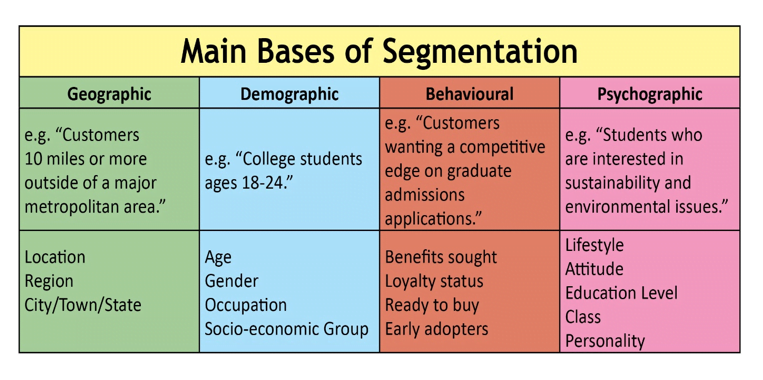A newly established company owner once previously described his intended audience as “all individuals.” While it’s wonderful to think that everyone would be interested in acquiring your product or service, defining your target market as such is not a good idea.
This definition (or the absence of it) not only generates considerably more work for you; it also does injustice to the real target market — by broadening your mission, you fail to teach and educate your audience on how what you are selling may enhance their lives.
In today’s competitive business world, having a marketing strategy that may help organizations stand out from the crowd is critical. Market segmentation, targeting, and positioning (STP) is one such technique. It is a three-step methodology that analyses products or services as well as customers to produce a personalized marketing campaign. This blog will explore the advantages of market segmentation, targeting, and positioning in businesses and how they may help organizations increase conversions and revenue.
What is Segmentation, Targeting, and Positioning (STP Marketing)?
Market segmentation, targeting, and positioning of a consumer-centric strategy for marketing communications. The STP approach aids in the delivery of more relevant, personalized communications to target audiences.
How to effectively segment a market in a business

1. Segmentation
- Geographic segmentation: This entails segmenting the market according to geographical criteria such as location, climate, and population density. This form of segmentation is important for firms that provide location-specific products or services or cater to certain cultural or regional preferences.
- Demographic segmentation: This entails segmenting the market according to demographic criteria including age, gender, income, education, and occupation. This form of segmentation is advantageous for firms that provide products or services to specific age groups or economic levels.
- Behavioural segmentation: This entails segmenting the market according to consumer behaviour, such as purchasing habits, brand loyalty, and product usage. This form of segmentation is advantageous for firms that provide products or services that appeal to specific consumer behaviours or preferences.
- Psychographic segmentation: This entails segmenting the market based on psychological criteria including personality, values, attitudes, and lifestyle. This form of segmentation is beneficial to firms that provide products or services that cater to specific lifestyle preferences or beliefs.
2. Targeting
Consider the following questions for each section when targeting your audience:
- Is the segment large and profitable enough to merit targeting?
- Is there a measurable difference between this part and others?
- Can Marketing and Sales effectively reach this segment?
- Can your organization meet this segment’s needs without any barriers?
Assess segment viability using strategic planning models such as PESTLE analysis.
It takes time and effort to target a sector. To optimize your marketing positioning, concentrate on one sector at a time.
3. Positioning

To effectively position your product or service in your target market:
- Consider demographics, psychographics, and preferences to understand your target groups’ motives and pain concerns.
- Examine your product/service from the standpoint of your chosen market niche. Determine which characteristics or benefits are most relevant and appealing to them.
- Create a positioning map to assess your brand’s standing with respect to competitors. This visual tool maps brands according to important factors that influence brand choices.
- Select two critical qualities for your target segment’s brand-choosing process and put them on the positioning map.
- To find market opportunities, examine where your competitors thrive or fall short in these areas.
- Position your marketing efforts to coincide with your audience’s requirements and aspirations, capitalizing on the open market opportunities you’ve found.
Benefits of Market Segmentation, Targeting, and Positioning
- Personalization: STP marketing enables organizations to establish personalized marketing efforts that target certain client segments. Businesses may personalize their marketing messaging to resonate with their target audience by knowing the requirements and preferences of distinct client segments, resulting in improved engagement and conversion rates.
- Cost-effectiveness: By directing marketing efforts towards the most lucrative client segments, STP marketing can help firms save money. Businesses can optimize their marketing budget and avoid spending resources on useless campaigns by focusing on the most profitable areas.
- Competitive advantage: By developing a distinct value proposition that resonates with its target audience, STP marketing can assist firms in differentiating themselves from their competition. Businesses can acquire a competitive edge and expand their market share by portraying their products or services as the best solution for the needs of their target audience.
- Improved customer satisfaction: Businesses may boost customer happiness and loyalty by developing personalized marketing efforts that suit the individual demands and preferences of their target audience. Customers are more likely to become repeat customers and promote a business when they believe the company understands their needs and provides solutions that satisfy their expectations.
Successful Market Segmentation, Targeting, and Positioning
1. AllBirds

There are numerous shoe brands on the market, same like there are numerous eating opinions. But that didn’t stop AllBirds from carving out a new niche in a crowded market full of comfortable, active shoe options.
How did AllBirds differentiate itself from the competition? By increasing its environmental awareness and emphasising it in its marketing. According to the AllBirds website, the business “crafts with planet-friendly natural materials, like merino wool and eucalyptus trees, because they’re our best chance for a sustainable future.”
At first appearance, AllBirds sneakers don’t appear to be all that different from conventional running or walking shoes. However, its target audience is aware of the distinction.
2. Coca-Cola

Another corporation that has effectively employed STP marketing is Coca-Cola. Coca-Cola has positioned themselves as the go-to beverage for people looking for a refreshing and fulfilling drink by segmenting their target audience based on their demand for a refreshing and energising drink. Coca-Cola is a popular carbonated soft drink sold in more than 200 countries, with over 1.8 billion daily servings worldwide.
The Coca-Cola Company owns over 500 brands, including the world’s best-selling carbonated beverages, Coca-Cola and Diet Coke. Coca-Cola has an active Twitter account and uses it to promote new products and campaigns. Coca-Cola provides limited edition flavours and collections, such as the Coca-Cola Value Collection.
Coca-Cola has a long history of environmental efforts, including water sustainability, women’s empowerment, community well-being, sustainable packaging, climate preservation, human and labour rights, and sustainable agriculture.
3. Hinge

Hinge is an excellent example of a company that has successfully used STP marketing. Hinge, a relatively new dating app, has swiftly garnered popularity and legitimacy in the congested online dating industry. Unlike other platforms, Hinge’s unique approach has made it a user favourite, as it focuses on creating genuine connections and meaningful partnerships.
Surprisingly, Hinge has set out on a mission to make its own app obsolete. Its purpose is to design an app that consumers eventually delete. This customer-centric strategy has helped Hinge stand out and garner trust, distinguishing it from its competition. Hinge has effectively established a highly sought-after online dating experience by prioritizing /the needs and desires of its audience, making it a dependable and preferred alternative for many.
In conclusion, market segmentation, targeting, and positioning are essential components of a successful marketing strategy. By understanding the needs and preferences of different customer segments, businesses can create personalized marketing campaigns that resonate with their target audience, leading to higher engagement and conversion rates. By implementing STP marketing, businesses can gain a competitive advantage, improve customer satisfaction, and increase their revenue.







